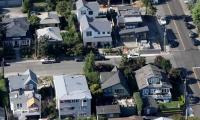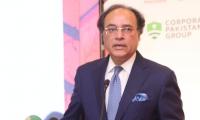PESHAWAR: Defence Minister Pervaiz Khattak and Khyber Pakhtunkhwa Chief Minister Mahmood Khan are at loggerheads over the Bus Rapid Transit (BRT) project as the former has challenged the provincial inspection team's report.
The inquiry report on the multi-billion and long-delayed BRT project highlighted a multitude of technical errors, faulty design and inept planning that caused heavy losses to the exchequer. The 27-page report, compiled by the Provincial Inspection Team on the orders of the Khyber Pakhtunkhwa Chief Minister Mahmood Khan was submitted to the government on January 30.
Speaking in Geo News' show ‘Jirga,’ Khattak challenged the report and called it 'erroneous'. He said that the critics must prove how come the project's expense got 25 percent increase.
The damning report has listed the following findings:
a) That, havoc has been played with the public money through faulty planning and designing, negligence in execution of work, and poor management of the project. The relevant reports of the consultant like feasibility study, drainage report, geotechnical report, highway report, structure report, traffic report, survey and utilities report etc. were found deficient resulting into frequent design changes during execution of work causing delay in timely completion of the work as well as loss to the public exchequer.
b) That the BRT corridor should have been preferably made elevated throughout its length which could have avoided the present traffic jam and also catered by future increase in mixed traffic. Presently the traffic congestion has been found at places where the BRT stations have been constructed at-grid rather than underground. Further, the post-BRT carriageway width for mixed traffic at the locations of BRT bus stations have been reduced by 40 percent on average as compared to pre-BRT conditions. Moreover, the non-maintenance of uniform number of lanes for mixed traffic through BRT route had created funnel like situation/bottleneck at the locations of BRT bus stations which added to the cause of traffic congestion.
c) That, in Reach-III of the project at the University Road, the approaches for the BRT bus stations near University of Peshawar and Board of Intermediate & Secondary Education (BISE) Peshawar colony have been constructed on walkways adjacent to government buildings. These approaches could have been constructed by acquiring small piece of land from government entities free of cost which would have removed hindrance from the walkways. Further, the canopies of the underpasses have also contributed in reducing width of the carriageway for mixed traffic.
d) That, signals have been designed for pedestrian zebra crossings so that passengers could reach the centre of the road and move up to the elevated BRT corridor through elevator or escalator. Although such signals will provide easy and safe access to the passengers but will also result into mixed traffic congestion.
e) That, there was no provision in the revised PC-I for installation of louvers and sound barriers at the elevated portions of Reach-II of the project which are required to safeguard the privacy of the buildings and counter the noise pollution in the vicinity. Moreover, the drainage system for elevated portion of the BRTproject also needed to be properly designed.
f) That, no pedestrian crossing other than BRT bus station approaches had been planned in the project.
g) That, the washrooms at the BRT bus stations were being constructed without proper foundation and lintel beams, with poor quality brick work.
h) That, the bike lane had not been maintained throughout the BRT corridor. It had been omitted at some locations while at some places it was combined with mixed traffic lane which raises question on the adherence to the requirement of the ADB in this regard as claimed by the Peshawar Development Authority (PDA).
i) That, concrete work of the project had been executed in stretched up to 40 metres in length instead of casting them in panels.
Therefore the work was not done according to standard engineering practice. Resultantly, cracks were found propagating in the concrete works.
Hospital management responded that only one post of BS-19 was vacant which is to be filled through direct recruitment
PMLN does not have a mandate from the people for privatising the SOEs: says Rabbani
Administrative Service Ali Hussain Malik and made him OSD in the Establishment Division
Establishment Division had notified Rizvi’s appointment as IGP Islamabad on March 30, but the Punjab government...
A British citizen of Pakistani origin has lodged formal complaint against FIA officer, alleging torture during a...
Former COAS admitted the army extended full support to Imran Khan’s government







